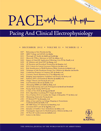VIEWPOINT
Augmentation/Attenuation of the QRST Complexes and Their Effects on the QT/QTc: A Heretofore Overlooked Important Association
First published: 04 October 2012
Address for reprints: John E. Madias, M.D., Division of Cardiology, Elmhurst Hospital Center, 79–01 Broadway, Elmhurst, NY 11373. Fax: 718-334-5990; e-mail:
[email protected] No abstract is available for this article.
References
- 1
Madias JE.
Significance of shortening of the mean QRS duration of the standard electrocardiogram in patients developing peripheral edema.
Am J Cardiol
2002; 89: 1444–1446.
- 2
Madias JE.
QTc interval in patients with changing edematous states: Implications on interpreting repeat QTc interval measurements in patients with anasarca of varying etiology and those undergoing hemodialysis.
Pacing Clin Electrophysiol
2005; 28: 54–61.
- 3
Madias JE,
Macfarlane PW.
Artificial attenuation of ECG voltage produces shortening of the corresponding QRS duration: Clinical implications for patients with edema.
Pacing Clin Electrophysiol
2005; 28: 1060–1065.
- 4
Wakimoto H,
Izumida N,
Asano Y,
Hiraoka M,
Kawara T,
Hiejima K,
Hirao TK, et al.
Augmentation of QRS wave amplitudes in the precordial leads during narrow QRS tachycardia.
J Cardiovasc Electrophysiol
2000; 11: 52–60.
- 5
Madias JE.
“Heart rate-dependent” electrocardiographic diagnosis of left ventricular hypertrophy.
Pacing Clin Electrophysiol
2012 (in press; doi: 10.1111/j.1540-8159.2012.03404.x. [Epub ahead of print]).
- 6
Talbot S.
QT interval in right and left bundle-branch block.
Br Heart J
1973; 35: 288–291.
- 7
Das G.
QT interval and repolarization time in patients with intraventricular conduction delay.
J Electrocardiol
1990; 23: 49–52.
- 8
Guidance for Industry: E14 Clinical Evaluation of QT/QTc Interval Prolongation and Proarrhythmic Potential for Non-Antiarrhythmic Drugs. U.S. Department of Health and Human Services, Food and Drug Administration, Center for Drug Evaluation and Research (CDER), and Center for Biologics Evaluation and Research (CBER). Rockville, MD, Food and Drug Administration; October 2005. Available at: http://www.fda.gov/downloads/RegulatoryInformation/Guidances/ucm129357.pdf (accessed May 7, 2012).




